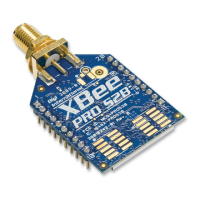Transmission, addressing, and routing Throughput
XBee/XBee-PRO ZigBee RF Modules User Guide 68
Throughput
Throughput in a ZigBee network can vary by a number of variables, including: number of hops, encryption
enabled/disabled, sleeping end devices, failures/route discoveries. Our empirical testing showed the following
throughput performance in a robust operating environment (low interference).
Data throughput
1
ZDO transmissions
ZigBee defines a ZigBee Device Objects layer (ZDO) that can provide device and service discovery and network
management capabilities. This layer is described below.
ZDO
The ZDO is supported to some extent on all ZigBee devices. The ZDO is an endpoint that implements services
described in the ZigBee Device Profile in the ZigBee specification. Each service has an assigned cluster ID, and
most service requests have an associated response. The following table describes some common ZDO services.
Configuration Data Throughput
1 hop, RR, SD 35 kb/s
1 hop, RR, SE 19 kb/s
1 hop, RE, SD 25 kb/s
1 hop, RE, SE 16 kb/s
1 hop, ER, SD 21 kb/s
1 hop, ER, SE 16 kb/s
4 hops, RR, SD 10 kb/s
4 hops, RR, SE 5 kb/s
RR = router to router
RE = router to end device (non-sleeping)
ER = end device (non-sleeping) to router
SD = security disabled
SE = security enabled
4 hops = 5 nodes total, 3 intermediate router nodes
1. Data throughput measurements were made setting the serial interface rate to 115200 b/s, and measuring
the time to send 100,000 bytes from source to destination. During the test, no route discoveries or failures
occurred.
Cluster Name Cluster ID Description
Network Address Request 0x0000 Request a 16-bit address of the radio with a matching 64-bit address (required
parameter).
Active Endpoints Request 0x0005 Request a list of endpoints from a remote device.
LQI Request 0x0031 Request data from a neighbor table of a remote device.

